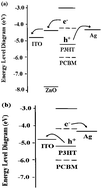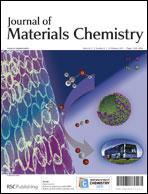ZnO nanoparticulate thin films were fabricated on flexible indium tin oxide (ITO) covered polyethylene terephthalate (PET) substrates by spin coating technology and were used in flexible solar cells with a hybrid polymer, due to the benefit of low temperature processes. The flexible solar cells with a structure of PET/ITO/ZnO/regioregular poly(3-hexylthiophene-2,5-diyl) (P3HT):[6,6]-phenyl-C61-butyric acid methyl ester (PCBM)/Ag have shown a photovoltaic performance with open circuit voltage of 0.56 V, short-circuit current density of 12.55 mA cm−2, fill factor of 0.36 and power conversion efficiency of 2.51%. The opposite J–V curves of the devices with ZnO and without ZnO were attributed to the opposite charge transport directions, which suggested the electron transport and hole blocking role of ZnO. The photoluminescence intensity of P3HT was totally quenched in the P3HT:PCBM thin film while there was no photoluminescence quench in the ZnO/P3HT double layer thin film, which clearly indicates that the exciton dissociation occurs at the interface between P3HT:PCBM instead of that between ZnO and P3HT. Therefore, it is reasonable to infer that the electrons transported to ZnO are from the lowest unoccupied molecular orbital (LUMO) of PCBM instead of the LUMO of P3HT according to the quenching experiment results combined with the J–V curve and energy level diagram. The identification of the charge transport directions and the exciton–dissociation interface will benefit the further improvement of photovoltaic performance by optimization of material selection, device design and process technology.

You have access to this article
 Please wait while we load your content...
Something went wrong. Try again?
Please wait while we load your content...
Something went wrong. Try again?


 Please wait while we load your content...
Please wait while we load your content...